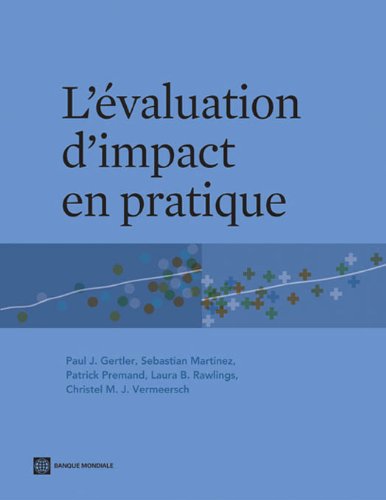Lire Impact Evaluation in Practice; L'évaluation d'impact en pratique gratuitment maintenant en ligne, livre. Vous pouvez également télécharger des bandes dessinées, magazine et aussi des livres. Obtenez en ligne Impact Evaluation in Practice; L'évaluation d'impact en pratique aujourd'hui.

===>> Cliquez ici pour lire un livre gratuit<<===
Veuillez suivre les instructions étape par étape jusqu'à la fin pour obtenir gratuitement les Impact Evaluation in Practice; L'évaluation d'impact en pratique. Profitez-en !!
This book offers an accessible introduction to the topic of impact evaluation and its practice in development. While the book is geared principally towards development practitioners and policymakers designing prospective impact evaluations, we trust that it will be a valuable resource for students and others interested in using impact evaluation. Prospective impact evaluations should be used selectively to assess whether or not a program has achieved its intended results, or to test alternatives for achieving those results. We consider that more and better impact evaluation will help strengthen the evidence base for development policies and programs around the world. If governments and development practitioners can make policy decisions based on evidence - including evidence generated through impact evaluation - our hope is that development resources will be spent more effectively, and ultimately have a greater impact on reducing poverty and improving people’s lives. The three chapters in this handbook provide a non-technical introduction to impact evaluations, including “Why Evaluate” in Chapter 1, “How to Evaluate” in Chapter 2 and “How to Implement Impact Evaluations” in Chapter 3. These elements are the basic ‘tools’ needed in order to successfully carry out an impact evaluation. From a methodological standpoint our approach to impact evaluation is largely pragmatic: we think that the most appropriate methods should be identified to fit the operational context, and not the other way around. This is best achieved at the outset of the program, through the design of prospective impact evaluation that can be built into the project’s implementation. We argue that gaining consensus between key stakeholders and identifying an evaluation design that fits the political and operational context is as important as the method itself. We also believe strongly that impact evaluations should be upfront about their limitations and caveats. Finally, we strongly encourage policymakers and program managers to consider impact evaluations in a logical framework that clearly sets out the causal pathways by which the program works to produce outputs and influence final outcomes, and to combine impact evaluations with monitoring and selected complementary evaluation approach to gain a full picture of performance.This book builds on a core set of teaching materials developed for the “Turning Promises to Evidence” workshops organized by the office of the Chief Economist for Human Development (HDNCE) in partnership with regional units and the Development Economics Research Group (DECRG) at the World Bank..
Lire Impact Evaluation in Practice; L'évaluation d'impact en pratique documentation complète en ligne gratuitement. Lecture Impact Evaluation in Practice; L'évaluation d'impact en pratique complet gratuit en ligne sans téléchargement. En levant vers l’article complet téléchargement des E-Books gratuits ? Vous pouvez lire ici
Veuillez suivre les instructions étape par étape jusqu'à la fin pour obtenir gratuitement les Impact Evaluation in Practice; L'évaluation d'impact en pratique, Livre Thermomix Gratuit En Telechargement. Profitez-en !!

Impact Evaluation in Practice; L'évaluation d'impact en pratique Info
.This book offers an accessible introduction to the topic of impact evaluation and its practice in development. While the book is geared principally towards development practitioners and policymakers designing prospective impact evaluations, we trust that it will be a valuable resource for students and others interested in using impact evaluation. Prospective impact evaluations should be used selectively to assess whether or not a program has achieved its intended results, or to test alternatives for achieving those results. We consider that more and better impact evaluation will help strengthen the evidence base for development policies and programs around the world. If governments and development practitioners can make policy decisions based on evidence - including evidence generated through impact evaluation - our hope is that development resources will be spent more effectively, and ultimately have a greater impact on reducing poverty and improving people’s lives. The three chapters in this handbook provide a non-technical introduction to impact evaluations, including “Why Evaluate” in Chapter 1, “How to Evaluate” in Chapter 2 and “How to Implement Impact Evaluations” in Chapter 3. These elements are the basic ‘tools’ needed in order to successfully carry out an impact evaluation. From a methodological standpoint our approach to impact evaluation is largely pragmatic: we think that the most appropriate methods should be identified to fit the operational context, and not the other way around. This is best achieved at the outset of the program, through the design of prospective impact evaluation that can be built into the project’s implementation. We argue that gaining consensus between key stakeholders and identifying an evaluation design that fits the political and operational context is as important as the method itself. We also believe strongly that impact evaluations should be upfront about their limitations and caveats. Finally, we strongly encourage policymakers and program managers to consider impact evaluations in a logical framework that clearly sets out the causal pathways by which the program works to produce outputs and influence final outcomes, and to combine impact evaluations with monitoring and selected complementary evaluation approach to gain a full picture of performance.This book builds on a core set of teaching materials developed for the “Turning Promises to Evidence” workshops organized by the office of the Chief Economist for Human Development (HDNCE) in partnership with regional units and the Development Economics Research Group (DECRG) at the World Bank..
Lire Impact Evaluation in Practice; L'évaluation d'impact en pratique documentation complète en ligne gratuitement. Lecture Impact Evaluation in Practice; L'évaluation d'impact en pratique complet gratuit en ligne sans téléchargement. En levant vers l’article complet téléchargement des E-Books gratuits ? Vous pouvez lire ici
